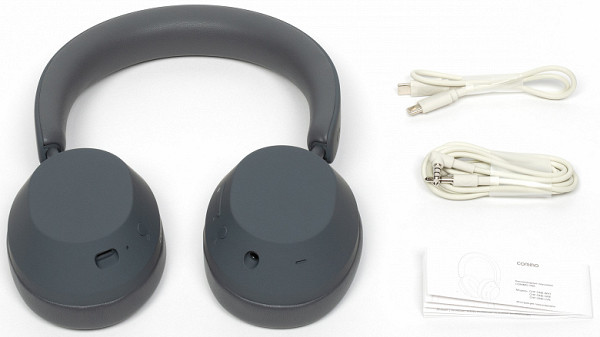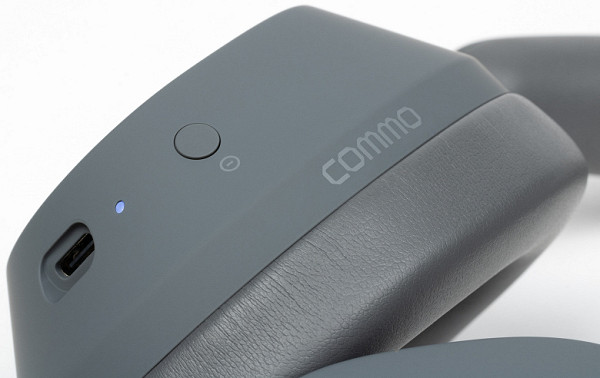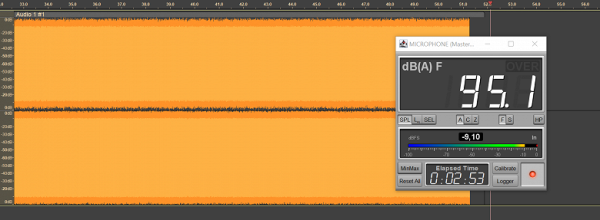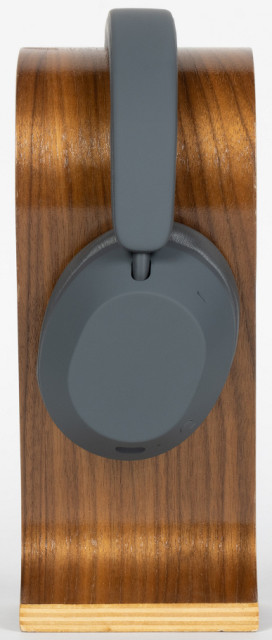In the spring of 2022, Yandex Market introduced its own Commo brand, starting sales of accessories for mobile electronics, such as power banks, screen protectors, chargers and cables. Later, more serious products appeared, including Commo One and Immersive wireless headphones. The One model is currently available, and the Immersive, which promises active noise cancellation and other advanced features, is due out in the near future.
Judging by the marketing materials, the Commo One is a typical budget headphone that offers basic features for modest money, such as wireless and wired connectivity, good design and comfort. One of the most attractive features is the claimed battery life of up to 95 hours.
However, as with any inexpensive headphones, the main questions relate to actual performance and sound. It's important to check how well they perform as advertised and how they sound, as even headphones with good performance may not be suitable for listening to music.
Specifications
| Declared frequency range | 20 Hz — 20 kHz |
|---|---|
| Impedance | 32 ohms ± 15% at 1 kHz |
| Sensitivity | 127 ± 3 dB at 1 kHz |
| Speaker | ∅40 mm |
| Connection | Bluetooth 5.3, wired (3.5 mm minijack) |
| Supported Codecs | SBC, AAC |
| Multipoint | No |
| Control | mechanical buttons |
| Noise suppression | No |
| Battery capacity | 650 mAh |
| Charging connector | USB-C |
| Battery life | up to 95 hours |
| Charging time | up to 2 hours |
| Fast charging | not declared |
| Dimensions* | 170×190×80 mm |
| Weight* | 270 g |
*Based on the results of our own measurements
Packaging and accessories
Commo One is packaged in a stylish black box with a detachable lid, which depicts the headphones and their main characteristics. The packaging design looks excellent and is on par with the packaging of flagship models from famous brands. There is nothing to suggest that there is a budget device inside, quite the opposite.

The package includes the headphones themselves, a USB-C to USB-C cable for charging, and an audio cable with two mini-jacks at the ends for a wired connection to the source.

The charging cable is 35 cm long, which may not seem like much, but is already acceptable for everyday use. Nowadays, when cables are often added to the kit just for show, such little things begin to please. However, the decision to include a cable with two USB-C connectors is controversial given that most chargers and computers come with USB-A connectors.

The audio cable is a standard length of 125 cm and is of average quality — a little thin and feels a little fragile, but overall reliable. The angled connector for connecting to the audio source brings additional convenience. At the top of the cable there is a plastic element with a microphone and a control button, which we will look at in more detail later.

Design and Construction
The headset is available in three colors: white, lavender and gray-green. We chose the latter option, which reveals hints of green only in bright daylight; the body is still mostly gray. The design of the headphones is very laconic and pleasant, creating the impression of solidity. However, it's worth noting that this is mainly due to the good sample that inspired the developers — the Commo One's appearance is very reminiscent of the Sony WH-1000XM5. However, there are differences, and, to be fair, the authors of many inexpensive headphones have recently been focusing on the WH series headphones.

The plastic body has a soft-touch coating that is pleasant to the touch, the matte surface looks very good and is resistant to fingerprints — from this point of view, everything is just great. The cups can rotate 90° in one direction and slightly in the other. This ensures not only wearing comfort, but also the convenience of wearing the headphones around your neck when not in use. The design of the Commo One is not foldable, so it is often easier to leave them around your neck than to try to put them in a backpack, for example.
At the bottom of the earcups there are connectors for connection and mechanical buttons for controlling the headset. There you can also see small microphone holes for using voice communication.

The ear pads are made of artificial leather, with soft foam filling inside. The fabric covering the speaker grilles is marked with “right”/“left” designations.

The inside of the headband has a soft pad filled with foam material, also made of leatherette, but slightly denser than that of the ear pads.

The earcups can slide out from the headband using a stepless adjustment mechanism, which is generally comfortable but not as smooth as we'd like. Adjustment may be a little jerky and accompanied by rustling and creaking. At first glance, it is difficult to determine that the Commo One is an inexpensive headphone, but such minor flaws may remind you of this during use.

The travel reserve of the cups is 3 cm on each side, this is quite enough to adapt the size of the headband to almost any head.
The ability to remove the ear pads is either absent or requires such effort that could harm the integrity of the structure. For headphones with a more affordable price, this is understandable — it’s unlikely that anyone will change the ear pads for them.
Connection
Wireless connection is carried out as standard: after turning on the headphones, they beep and automatically try to connect to previously paired devices. If there are none, they go into pairing mode. Next, you need to find the “• Commo One” device in the corresponding smartphone menu and establish a connection. The title is displayed with a "•" at the beginning, perhaps to illustrate that «comma» (comma) is Italian for an item in a list.
The list of supported codecs and their modes was obtained using the Bluetooth Tweaker utility. In this case, only two codecs are supported: SBC and AAC, which is quite enough for a budget headset.

The SBC's maximum Bitpool setting is set to 53, while the recommended High Quality profile is set to 51, allowing the codec to perform at its peak. Regarding AAC, the utility was unable to detect an upper bitrate limit, so we can assume that it is not limited, and most devices will use the standard value of 256 Kbps.
The quality of communication leaves a positive impression — the headphones work stably even in conditions of increased interference. There is practically no desynchronization of image and sound when watching videos and in simple games, but problems may arise when playing more resource-intensive games, such as Call of Duty Mobile; in such cases, switching to the SBC codec helps.
Wired connection is very simple: one end of the included cable (closer to the microphone) is connected to the headphones, and the other to the source. After this, the power to the headphones is automatically turned off and they go into passive mode.

Control
The headphones are controlled using physical buttons, which is satisfying — after all, manufacturers of budget headsets often use cheap sensors that do not always work reliably. Therefore, having high-quality buttons is a more preferable solution. The power button is located on the outside of the left cup and is activated by a long press. Nearby there is a small LED indicator that displays the status of the device and the battery charge level.

On the right cup there are two keys in the form of a “swing”, one of which has a small convex dot for orientation by touch. With short presses, these keys adjust the volume, and with long presses, they switch songs. Nearby there is a round button that, when pressed once, pauses the track and starts it again, and when pressed for a long time, it functions as the “play” and “stop” buttons. The same button allows you to answer an incoming call, reject it, or end it. The keys have a distinct click when pressed, and while the rocker requires some effort, it's not too much.

Exploitation
The headband of the headphones provides a good fit and has a wide range of size adjustments — it's very comfortable. The headphones fit securely on your head, which allows you not only to walk with them, but also to engage in jogging and other sports. While jumping rope or punching bags may be uncomfortable, they stay in place when running or doing incline exercises. Although water resistance is not declared, they will withstand small drops of sweat or rain, and the affordable price allows you not to worry too much about their safety.
However, there are a few drawbacks that may affect the ride comfort. The ear pads are soft and comfortable, filled with memory foam, but are made of average quality leatherette, which can cause your ears to sweat, especially in hot weather or during physical activity. In addition, the inner diameter of the ear pads is slightly smaller than usual — only 60x25 mm, so they can put unpleasant pressure on large curls of the ears. Passive sound insulation is at a high level due to the tight fit of the ear pads to the head due to rotating cups and foam filler. Accordingly, the risk of sound “leakage” is minimal — if you don’t listen too loudly, others will not know about your music selection.

Overall, the fit is quite secure and comfortable, but for those with large ears, it may not be very comfortable when playing sports on a hot summer day — this is worth keeping in mind.
Microphone for voice communication
To test the operation of both headset microphones, we use a specially prepared room and a monitor speaker system that reproduces a sweep tone. To obtain correct data on the frequency response of speakers, we first calibrate the measuring microphone and record a graph of their characteristics. We then use this information to correct the data collected from the headset microphones, which are located in the same location as the measurement microphone. Thus, we obtain accurate results about the frequency response of the tested microphones.

The physiology of the adult male voice includes a fundamental frequency of 85 to 155 Hz, while in women this range is from 165 to 255 Hz. However, for voice transmission, frequencies from 300 to 3400 Hz are usually used, which are called “voice”, since it is in this range that the formants responsible for speech intelligibility are located. Frequencies below this range are «cut off» not only due to transmission channel limitations, but also due to the presence of unwanted sounds such as the hum of engines or low-frequency crowd noise.
The Commo One microphone will probably not provide ideal and full sound: there may be hum in the lower mid-range and loss of naturalness due to a dip in the 800 Hz region. However, the frequencies that are important for speech intelligibility must be sufficiently transmitted to allow the microphone to cope with its primary task.
The voice is transmitted quite clearly and does not cause excessive fatigue to the listener. Answering a call, exchanging a few phrases or recording a voice message will be quite possible using Commo One. Although the manufacturer did not promise an active noise reduction system for calls, but since such a function is available, it is worth checking how the microphone copes with a noisy environment.

As for the peculiarities of the sound of the voice, in this case it sounds more full-bodied, but with a strong mumble. If not for the obvious lack of high frequencies, the result could have been very good. However, their insufficiency affects speech intelligibility, which is a negative point. So the choice between using built-in headphones or cable-mounted microphones is impossible — both are generally acceptable, but have a number of unpleasant drawbacks.
Autonomy and charging
The manufacturer promises an impressive level of autonomy for the headphones — up to 95 hours. This figure is truly impressive, especially considering that some competitors offer up to 60 hours of operation, and even the aforementioned Sony WH-1000XM5 claims up to 30 hours without active noise cancellation. However, it's always interesting to know how these numbers compare to reality, especially in our testing conditions, which are as close to real-life use as possible.
We run the test by turning on white noise at around 95 dB SPL, which is close to the 90-100 dB level preferred by most listeners. We then record the time the device operates while playing that sound and measure its duration. This approach allows you to evaluate the real autonomy of the headphones in conditions close to real ones.

Predictably, the headphones worked less than the stated time — 84 hours 50 minutes. But this is still a very impressive result — more than three days of continuous work! Simple math shows that even if you actively use the Commo One for five hours a day, you will have to charge it a couple of times a month. The charging process takes about two hours. It’s just important not to miss the moment when the headphone charge level becomes critically low. The headphones will notify you of this with a burning red indicator and a sound signal, after which they will be able to work for about an hour and a half. As a last resort, you can use a wired connection if the cable is at hand and the device has the appropriate connector.
Sound and frequency response measurements
The appearance of the Commo One hardly gives them away as budget headphones, but their sound does. It is not unambiguously bad, but rather a compromise. The headphones have an accentuated and slightly boomy low range, an uneven and indistinct midrange, and slightly ringing highs. It doesn't cause much irritation, but it doesn't cause much joy either. If you need high-quality bass, clear vocals and other joys of good sound, you will have to turn to flagship models from well-known manufacturers, the cost of which can be several times higher. However, for background listening to music and podcasts, the Commo Ones are fine, considering their price, they sound good. Let's show this on the frequency response graphs, starting with the Bluetooth connection, which is usually used more often than wired.

The frequency response graph shows the target curve provided by the manufacturer of the stand used, adapted for a specific device. This is an analogue of the so-called “Harman curve”, developed by the Harman International team led by Dr. Sean Olive. Because people perceive different frequencies of sound differently, even the most accurate measurements may not reflect the actual user experience. The target frequency response is used to compensate for these differences. The sound close to the target curve is assessed by hundreds of experiment participants as neutral, balanced, natural, etc. We compensated the resulting frequency response graph in accordance with the target curve in order to illustrate the subjective listening impressions as fully and clearly as possible.

The accentuated “hump” in the deep bass region gives the sound a booming sound, and the boost in the lower mids interferes with the perception of the midrange, which recedes into the background. However, you can listen to music without much irritation, especially considering the cost of the device. Let's see if the frequency response changes when using a wired connection.

There are changes, but they are not critical — all sound features remain at approximately the same level. Let us only note that due to a slight decrease in the emphasis on the bass, the mids become better perceived, but the dip in the upper part significantly reduces detail. In general, the sound changes a little, and subjectively it may even seem a little worse. When choosing a connection type, it is better to focus on the comfort of using headphones at a particular moment than on other factors — there are practically no reasons to prefer a wired connection. Let's take another look at the chart against the background of the target curve.

Let's compensate it according to it in order to more clearly see the sound features of the device. In this case, they are, of course, determined by a rise in the lower mids and a dip in the upper mids.

Results
For the price, the Commo One is an excellent choice. While they don't sound as great as some flagship models, they come at a significantly lower price. At the same time, they look attractive and are easy to use, although not without some drawbacks. Their autonomy stands out especially. In one of our previous reviews, we talked about how purchasing wireless headphones that are too cheap can be a compromise in quality. It’s better to add a little money and choose headphones from the “simply inexpensive” category rather than “ultra-budget” — the quality is usually better there. For example, Commo One is an excellent option for its price.




